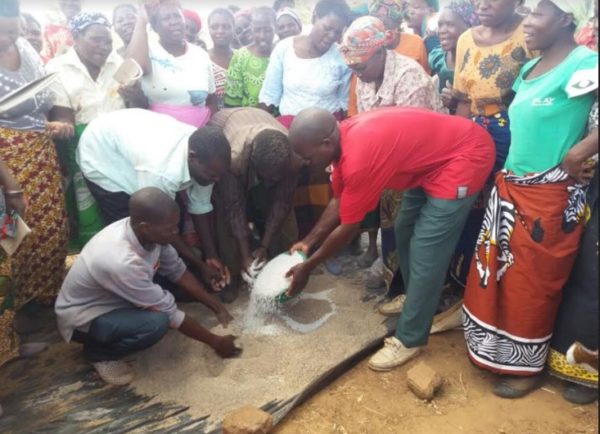Malawi farmers turning waste into fertiliser
Tryness Phiri, 35, is a small-scale farmer who has been into farming for over eight years. But over these years, her harvests from various crops has been less inspiring largely because of lack of farm inputs like chemical fertilisers.





“I usually harvested little because the crops I grew required fertiliser which I could hardly afford,” says Phiri, a resident of Kansonga Village, Traditional Authority (TA) Malenga in Ntchisi.
According to Phiri, every year she would need about K100 000 to buy chemical fertiliser for her farm but she could not manage.
Growing crops like maize, groundnuts and sweet potatoes has not been easy for her because their farm practices require huge investments. Her home had always been a perennial harbour for hunger and poverty.
But that is no longer the case now for Phiri as she has found a way to overcome her predicament in farming. This is making fertiliser by herself.
The woman is now making what is called Mbeya fertiliser from renewable waste, a practice that has improved her crop yield and reduced expenses on her agricultural practices.
With only K15 000, she is able to make four bags of fertiliser, which is enough to apply in her maize field. With what she has ventured into, Phiri is able to save K85 000.
The materials used for making this fertiliser are locally available and less costly. These are materials considered useless in communities like ash, animal dung and maize bran.
The process of making the fertiliser is also simple.
“We mix 20 kilogrammes (kg) of animal dung, 20kg of maize bran and 10 kilogrammes of ash.
There is also the addition of five litres of water and five kilogrammes of the type of fertiliser one would want to make,” Phiri says.
The ingredients are mixed together and kept in a sack bag with a plastic paper inside. After 14 days, one has a 50kg bag of fertiliser ready for use.
“Apart from being cheap, this fertiliser is very good because it contains manure which helps in retention of soil moisture for crop growth,” says Phiri.
Since the adoption of this fertiliser, Phiri is now able to harvest enough for both consumption and sale.
With the income generated from selling crop yields, she is also supporting the education of her children.
Rabson Sitambo, 37, is also another beneficiary of this initiative of making Mbeya fertiliser.
Previously, Sitambo would require K75 000 to buy fertiliser for his field. But now he makes three bags of fertiliser weighing 50kg with an investment of K10 500.
The making of organic fertilizer saves him K64 500 from procuring the same number of bags for chemical fertiliser.
“The use of Mbeya fertiliser has improved crop production with little investment on fertiliser application,” says Sitambo who comes from Kansonga Village, T/A Malenga in Ntchisi.
Both Phiri and Sitambo attribute their change of fortune to their membership in Mtuwo Cooperative.
With a membership of 20 people, two men and 18 women, the cooperative is one of the groups in the country benefiting from Cooperative Enterprise Pathways for Economic and Environmental Sustainability (Cepeesm) Project.
The project targets communities under various cooperatives and empower them with skills and knowledge in environmental sustainability through renewable waste.
Cepeesm project manager John Mulangeni says the project has four focal areas of women empowerment, youth participation, environmental conservation and use of renewable energy.
Their aim is to provide pathways that enable the growing cooperative movement in the country to become more economically and environmentally sustainable and inclusive.
It is through the environmental conservation and use of renewable energy components that the making of organic fertiliser falls under.
Mulangeni says the project appreciates the challenges farmers face due to soil fertility loss.
“The soil has lost its fertility and for one to realise bumper yields, there is always need for fertilizer application.
This project targets small scale farmers in order to train them in making fertiliser using locally available materials considered useless in communities,” Mulangeni says.
Since its inception in April 2015, the project has so far reached out to over 7, 000 direct beneficiaries out of the 8,000 targeted ones across the country.
There is hope that by March 2018, when the project ends, all targeted beneficiaries will have been reached.
Ntchisi is one of the districts which has benefited from Cepeesm project.
Cepeesm project officer Judith Chisiye says the skills that farmers in Ntchisi have gained in making organic fertiliser is a lifetime investment in their farming practices.
“We would like to encourage communities to utilize these skills. The good thing is that the materials for making this type of fertiliser are always available in their surroundings,” Chisiye says.
Apart from teaching cooperatives on how to make fertiliser, Cepeesm project also empowers farmers in how to make briquettes.
The briquettes are made from used book papers, newspapers and fallen tree leaves which are soaked in water for at least three days. After that, they are moulded and sun dried.
Through the skills gained from Cepeesm, Tryness Phiri looks into the future with optimism of doing better in earning a livelihood for her home.
“The skills I have acquired in making fertiliser will help me meet my household needs by increasing production levels of crops. The making of briquettes will help in conserving the environment,” Phiri says.
Follow and Subscribe Nyasa TV :


